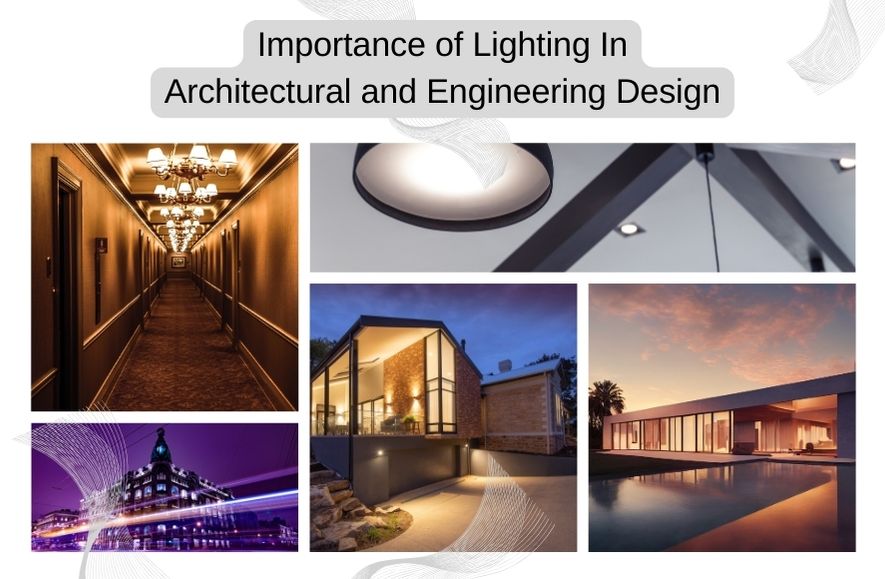Whether it be our houses or huge buildings we are affected by space, but the light dictates how we relate to space. Contemporary architectural & engineering lighting design is critical in the creation of a functional and motivating milieu.
Natural and artificial light combine for safety, productivity and good health. Intelligent lighting systems have emerged that helped engineers to think about safety planning in buildings differently. Changing any normal view of a structure into something extraordinary only requires just the right amount of light.
Natural Light Integration
Sunlight is the most sustainable and beneficial lighting source in building design, and is still the best. Windows and skylights are large and the amount of artificial lighting needed during the day can be reduced. Architects plan to open positions in a building to capture preferred daylight in different seasons.
Today, there are glass technologies for managing natural light and heat gain. Well placed windows create interesting shadows that animate space. Natural light also keeps building occupants’ circadian rhythms healthy. Better mood = better well-being: daylight connection to the outdoors.
Energy Efficiency
Modern lighting solutions in architecture & engineering focus heavily on energy conservation. In today’s world, artificial lighting design in buildings is almost entirely dictated by LED technology. Sensors that are smart can change light levels depending on occupancy and natural light available.
Energy efficient fixtures help buildings meet strict sustainability, operational cost requirements. Lighting zones enable you to control the light to the areas at specific times. Building automation works well with modern systems to achieve maximum energy usage. An application of good lighting design will make the carbon footprint of a building almost negligible.
Visual Comfort
Good lighting design relieves eye strain and makes it easy to work in comfortable places while doing different things. Different spaces have different light levels based on use and function. Through glare control, proper fixture selection and placement are used to achieve comfort of viewing conditions.
Before dropping off to harsh contrasts and shadows, lighting designers are anxious about over lit areas. It will help you choose the right color temperature for the different spaces and times, defining the right mood. Indirect lighting reduces visual fatigue in the workplace. It is focused where it’s most needed for task lighting.
Spatial Enhancement
Using light can make your space seem bigger, smaller or more dramatic. Uplighting helps to paint architectural features and creates the feeling of height. Wall washing techniques provide plain surfaces with depth and dimension. Accents are lit up to highlight art, textures and other design details all throughout a space.
The visual interest is provided by layer lighting, which also defines areas for functional use. Strategically lighting can help move naturally through space. It uses light that is good with fabric to display colors, which are really true and vibrant life-like colors.
Safety and Security
Building and outdoor lighting systems are designed well to allow safe navigation. Emergency lighting systems provide extremely critical illumination under conditions of power outages and evacuations. The ability of good exterior lighting to discourage unwanted activity, and the usefulness of security cameras, are greatly enhanced.
Pathway lighting shines along corridors and stairwells to ensure people are safely guided through at night. Motion sensors turn on light in low traffic areas as needed. Entry buildings in the building receive the right amount of lighting so entry and exit points are safe and welcoming. Underground lighting areas need careful lighting design.
Flexibility and Control
Modern lighting systems provide unprecedented control of the built environment. Spaces can be programmed for multiple uses during the day by programming scenes. Wireless controls have easy adjustments without the requirement of complex rewiring or renovation. The lighting system can be customized for individual users’ use to meet the users’ own needs and preferences.
Daylight harvesting systems are daylight harvesting systems that automatically close daylight harvesting systems to counter the natural and artificial light sources. Occupancy sensors turn lights on only when needed. Mobile devices provide smart integration with the lighting control.
Aesthetic Impact
Good lighting design makes architecture & engineering come to life. Light fixtures aren’t the only element of art that can help bring attention to architectural spaces; abstract art is not confined to the realm of artistic expression. Dynamic lighting systems are for special events and seasons and are changing the atmosphere.
The lighting of a building’s facade makes the building into a nighttime landmark and an attraction. The color of spaces is able to change according to mood and purpose. Lighting helps to create hierarchy within the visual structure of a space and helps to focus attention on key design features. By strategic shadows, architectural spaces can be dramatized and enigmatic.
Ending Note
Illuminating is not the whole of lighting design: it has become an integral part of contemporary building design. Natural and artificial light are combined to provide a thoughtful experience and interaction with spaces.
As technology advances, lighting will become more of a means to build sustainable, comfortable and inspiring environments with time. Smart lighting solutions promise even more innovative ways to improve architectural spaces in the future.




